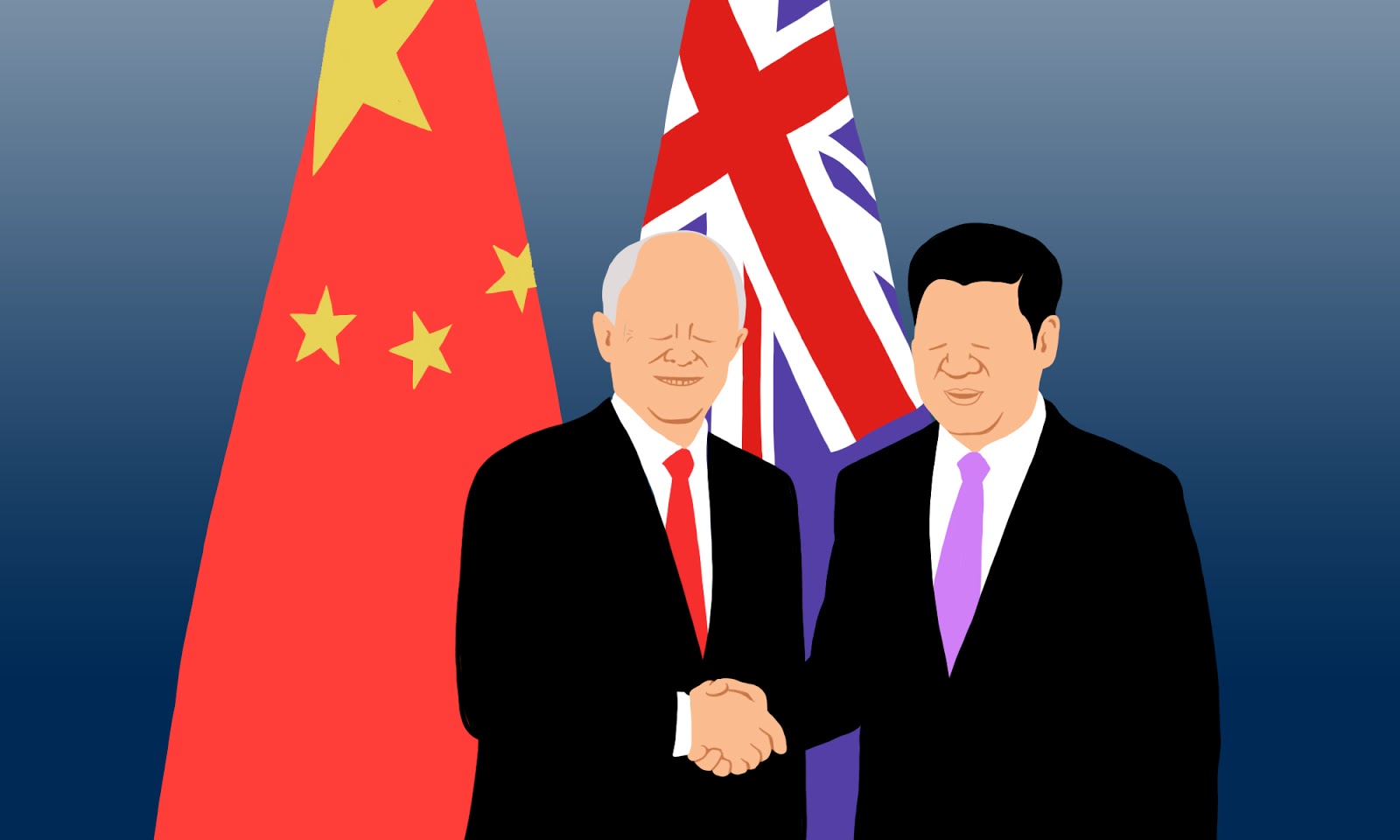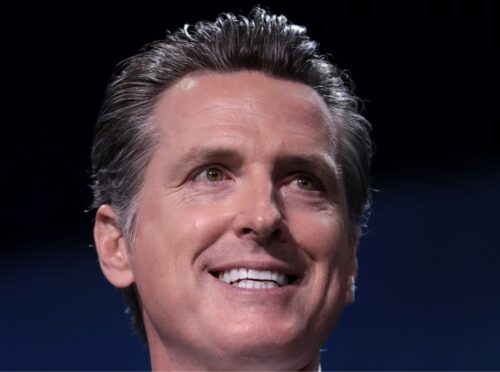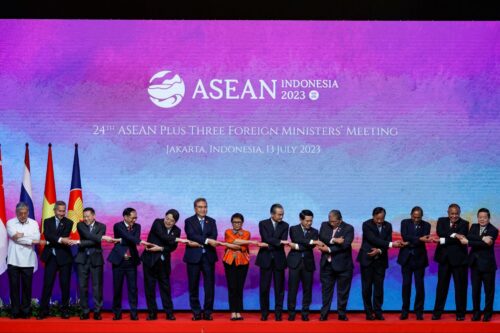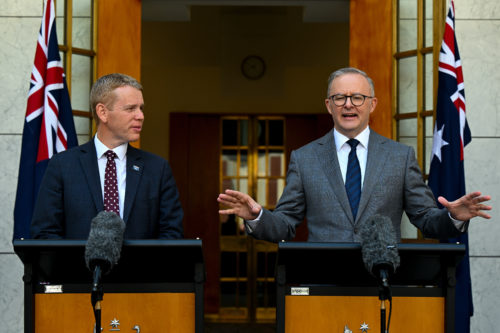Australia-China relations: A short history of a downward spiral
How did the Australian-Chinese relationship get so bad, so fast? Australia’s woes offer lessons about “managing China” that are more complex than they first appear.

Australia is the Western nation most economically dependent upon China. Yet the decline in its relations with China has become a paradigm for fraught relations with Beijing (the United States, European Union, and other Western governments have all condemned the latest incident of Chinese “wolf warrior” diplomacy towards Australia). The bilateral trading bonanza that fueled Australia’s quarter-century without an economic recession has become, by Canberra’s own description, a target for “disruptive measures” from Beijing, on a scale not experienced even by countries that have territorial disputes and difficult histories with China.
How did a nation that sells 40 percent of its exports to China and has 1.2 million ethnic Chinese residents (in a population of some 25 million) end up in this situation, and what lessons does Australia’s experience hold for others in their dealings with Beijing?
Beijing’s concern about Australia’s role in a perceived U.S.-led strategy to “contain” China can probably be traced to President Barack Obama’s 2011 announcement of the American “pivot to Asia” in a speech to Australia’s Parliament. This announcement included regular rotations of U.S. Air Force and Marine forces through northern Australia, providing new military staging points in the Western Pacific that are largely beyond the reach even of China’s improving military capabilities. But the snowballing Australian media coverage of issues touching on China, which now features prominently in Beijing’s list of grievances with Canberra, arguably began in 2015 with uproar over a private Chinese firm obtaining a lease over the port of Darwin, driven by alleged security concerns over Beijing’s intent.
From 2016 through 2020, a growing tide of Australian media reports and commentary has painted a picture of a Chinese subversive threat to Australian social and political life, and of increasingly hostile attitudes towards China in Canberra that some allege are being driven by the security agencies and particular individuals. A book by the academic Clive Hamilton purported to show widespread subversion by Beijing-directed interests, while an Australian politician resigned in a scandal involving links with Chinese businessmen and statements supporting Beijing’s policy in the South China Sea. The media has reported allegations of intimidation and law enforcement activities conducted by Chinese state agents covertly in Australian cities, potential links between Chinese-Australian politicians and civil society groups with possible links to China’s United Front Work Department, and an alleged scheme by Beijing to plant a spy in Australia’s Parliament, involving a Chinese Australian man later found dead in unusual circumstances.
This drumbeat of negative media reporting concerning China likely aggravated perceptions in Beijing that Canberra was trying to “bell the dragon” by leading international opinion toward more skeptical treatment of Chinese actors in some areas, including fields critical to China’s long-term development priorities. Canberra’s banning of firms subject to foreign state direction from equipping the nation’s 5G telco networks, tightening of the foreign investment review process, establishment of a taskforce to counter foreign espionage in universities, and introduction of legislation to counter covert foreign interference operations across Australian society have all been assumed to mainly reflect concerns about Beijing-directed activities. Some members of Australia’s Parliament have been vocal in calling for tougher policy toward China, recently in coordination with counterparts in the UK and Europe.
The scale of the threat from covert foreign interference to Australia’s political processes and social cohesion has been reinforced in public statements by Australian security chiefs, without expressly naming China. A defense of the foreign interference law by one Australian Prime Minister, using Mao Zedong’s language of “standing up,” angered Beijing, as did the subsequent Prime Minister’s assertion that China should no longer claim “developing country” WTO status. The detention in China of a Chinese-Australian writer, who was charged eight months later with espionage over Canberra’s protests, further aggravated opinion toward a China already viewed as increasingly threatening by the Australian public, against a backdrop of events in Hong Kong, Xinjiang, and the South China Sea.
The situation reached boiling point with several events in 2020:
- Canberra’s announcement through the media that it would advocate an independent enquiry into the global pandemic’s origin infuriated Beijing.
- Australia rejected the legal basis for China’s sovereign claims in the South China Sea.
- Australian police reportedly conducted raids on Chinese journalists and another politician whose associates were suspected of acting for Beijing.
- Legislation passed in December 2020 that enables Australia’s federal government to veto agreements made by the Australian states with foreign interests is perceived as targeting China’s Belt and Road Initiative.
- And the “blatant racial profiling” by an Australian Senator of Chinese-Australians as potential agents of Beijing — even if their families left China decades ago — failed to draw any condemnation from the Australian government.
All these events were referenced in the list of “14 grievances” provided recently by China’s embassy in Canberra, although subsequently backpedaled. Against this backdrop, a growing range of Australian exports to China are faced with rumored or implemented import restrictions that are increasingly openly represented as punishment for Australian misbehavior, even as exports to China keep rising. The refusal of Chinese officials to take calls from Australian counterparts reflects a stance that places both blame for the tensions and burden for improving relations entirely with Australia, and is unlikely to be mitigated by Canberra’s WTO action against Beijing for trade malpractices.
The recent tweet by a Chinese diplomat highlighting war crimes by Australian soldiers has drawn especial ire in Canberra. But to an extent, it reflects the toxic media climate that has evolved in Australia around almost every issue touching on China, often characterized by excessive insinuation and defamatory attacks on institutions and individuals. Australian media coverage is mentioned in Beijing’s “14 grievances,” with even the contributions of a specific think tank named as an irritant.
A free press is a non-negotiable pillar of a liberal democracy, and one which Beijing has sought to subvert in Australia. But it has also aggravated Canberra’s difficulties in finding the domestic political balance needed to pursue a stable and broadly-supported China policy. Media propagation of an image of Beijing’s pervasive hidden hand, often extending beyond what public evidence readily supports, also breeds anxiety among Chinese Australians about attracting suspicion based on ethnicity — to the point of undermining the government’s capacity to recruit and retain personnel with relevant skills for China policy.
Australia’s experience in defining its relationship with Beijing offers lessons for other nations in managing coercive pressures. But it also reveals a form of populism on China policy that frames decisions through emotion or ideology, rather than facts. Canberra now faces a monumental challenge to meet its self-defined goal of restoring working relations with Beijing, and it is difficult to see the otherwise welcome political support from other countries providing much assistance.






